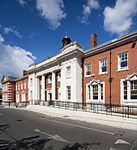William Booth Memorial Training College
1929 establishments in EnglandArt Deco architecture in LondonBuildings and structures completed in 1932Buildings and structures in the London Borough of SouthwarkCamberwell ... and 6 more
Educational institutions established in 1929Further education colleges in LondonGiles Gilbert Scott buildingsGrade II listed buildings in the London Borough of SouthwarkSalvationism in EnglandThe Salvation Army

William Booth College on Champion Park, Denmark Hill in the London Borough of Southwark, is the headquarters of The Salvation Army leadership and officer training which delivers education and training programmes for the United Kingdom. Designed by Sir Giles Gilbert Scott, the college is a memorial to William Booth. The college has been listed Grade II on the National Heritage List for England since September 1972.
Excerpt from the Wikipedia article William Booth Memorial Training College (License: CC BY-SA 3.0, Authors, Images).William Booth Memorial Training College
Champion Park, London Camberwell (London Borough of Southwark)
Geographical coordinates (GPS) Address Phone number Website External links Nearby Places Show on map
Geographical coordinates (GPS)
| Latitude | Longitude |
|---|---|
| N 51.4677 ° | E -0.0886 ° |
Address
William Booth College
Champion Park
SE5 8BQ London, Camberwell (London Borough of Southwark)
England, United Kingdom
Open on Google Maps









